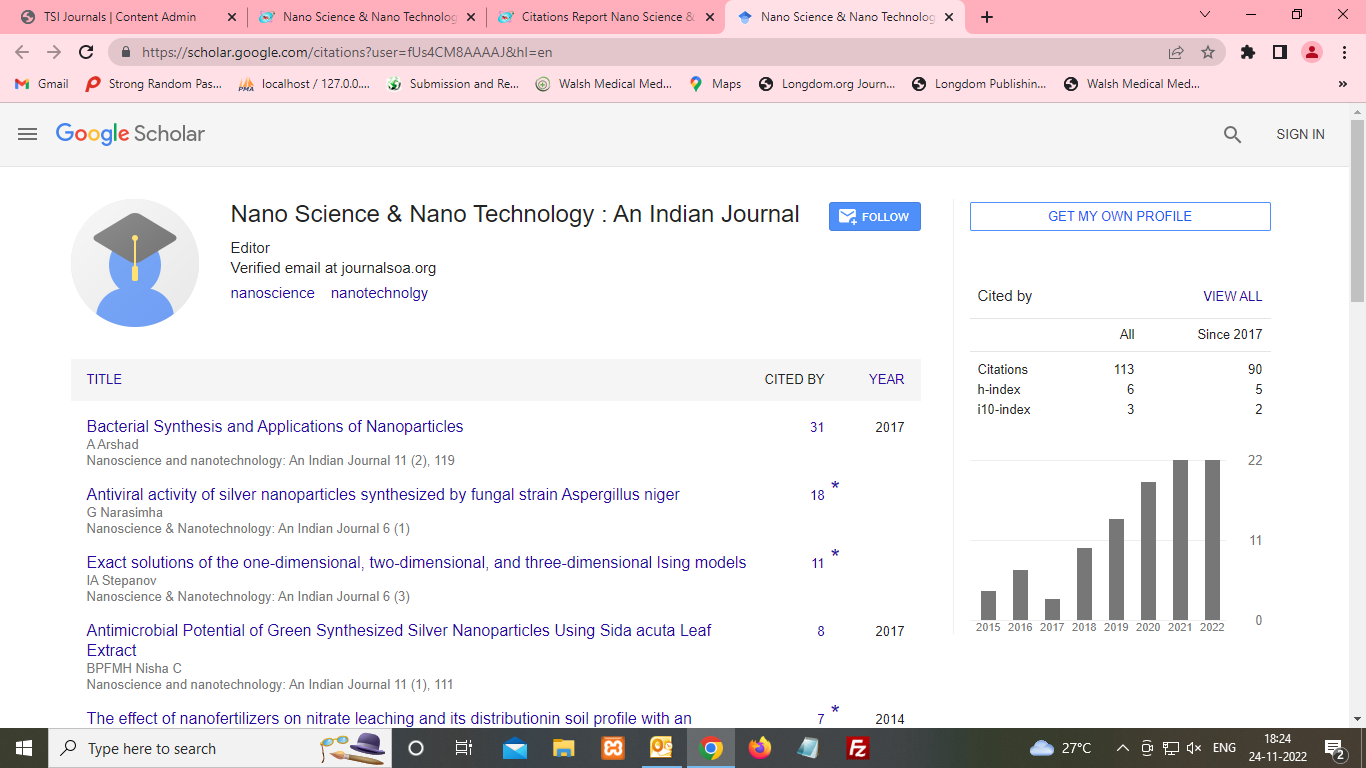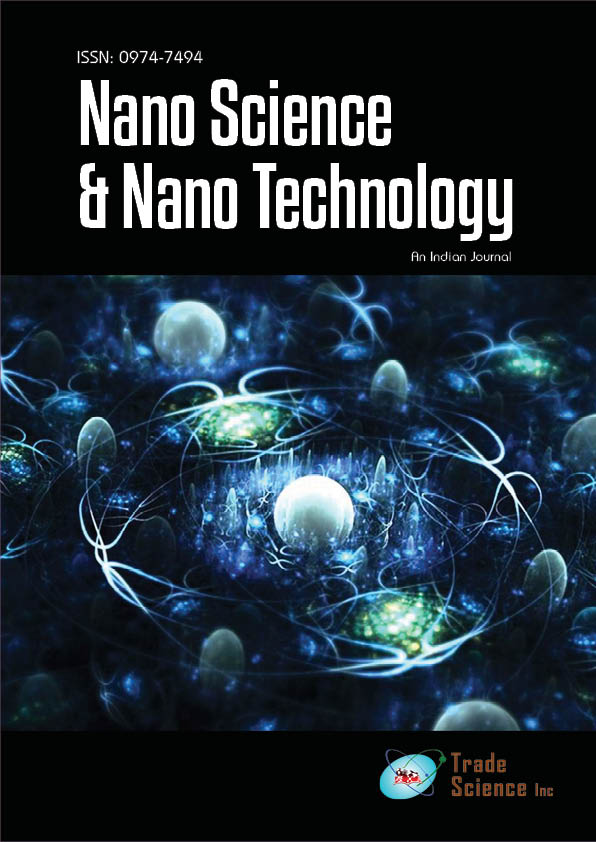Research
, Volume: 15( 2) DOI: 2021;15(2):106CuO Nanoparticles Synthesis by Sol- gel Method and Characterization
Madhav Jadhav*
Department of Physics, SMBS Thorat College, Maharashtra, India
*Corresponding author: Madhav Jadhav, Department of Physics, SMBS Thorat College, Maharashtra, India
Tel: + 9881800832;
E-mail: mjsmbst2008@gmail.com
Received: September 23, 2021; Accepted: October 07, 2021; Published: October 14, 2021
Citation: Madhav J. CuO Nanoparticles Synthesis by Sol- gel Method and Characterization. Nano Sci Nano Technol. 2021;15(2):106.
Abstract
Abstract
CuO one of the useful metal oxide and has many applications in different fields. CuO acts as a semiconductor. In the present work, the main objective is to synthesize CuO nanoparticles using a low cost Sol- Gel process at room temperature and study the material by using the characterization techniques XRD and UV-visible spectrum. Crystallites size was calculated from Scherer’s formula using most peak of CuO. The XRD pattern of CuO shows the highest intensity diffraction peak at 38.540 correspond to (111) plane. The average crystallite sizes of CuO particles were found to be 16.57 nm. CuO nanoparticle showed maximum absorption at wavelength 322 mm. The calculated energy band gap of CuO were 3.14 eV.
Keywords: CuO nanoparticles; Sol-Gel method
Introduction
Nanoparticles are different from bulk materials and isolated molecules because of their unique optical and, electronic and chemical properties. In the universe there is number of metal oxides are available in nature but some of the metal oxides are most useful in accordance with their applications in science and technology [1]. Some metal oxides like TiO2, ZnO and Fe3O4 are proved for number of applications. Similarly, CuO is also one of the useful metal oxide and has many applications in different fields.
CuO acts as a semiconductor and has energy band gap nearly 2.6 eV. Semiconductor materials are interesting because of their great practical importance in the devices such as electrochemical cell, gas sensors, magnetic storage devices, field emitters, high Tc-superconductors, Nano fluids, and catalysts etc. in the past decades, various methods have been proposed to produce CuO nanoparticles with different sizes and shapes such as thermal oxidation, sonochemical, combustion and quick precipitation [2]. The properties of nanomaterials will depend mostly on the Nano powders size, morphology and specific surface area of the prepared materials. Some aspects are strongly depending on the preparation methods. In the present work, the main objective is to synthesize CuO nanoparticles using a low cost Sol-Gel process at room temperature and study the material by using the characterization techniques XRD and UV-visible spectrum.
Materials and Methods
Experimental details
The preparation was carried out in room temperature. All chemicals were used analytical grade without further purification. Double distilled water was used for all the experiments. CuCl2, NaOH, Acetic acid chemicals were used. CuO Nano particles were prepared by Sol-gel method. The aqueous solution of CuCl2. 2H2O (0.2M) (M.W. 170.48) is prepared in cleaned Beaker. 1 ml of glacial acetic acid is added to above aqueous solution and heated to 800C with constant stirring. 8 M. NaOH is added to above heated solution till PH reaches to 10.2. The colour of solution turned from blue to black immediately and the large amount of black precipitate is formed immediately. The obtained precipitate was dried in air for 24 hrs. This powder is further used for the characterization of CuO nanoparticles. The crystal phase of CuO nanoparticles were determined by X-Ray Diffractometer (XRD) and band gap was determined by UV-Visible spectrum.
Results and Discussion
The structural analysis of CuO nanopowder was recorded using an Burker D-8 X-Ray diffrctometer operated at 30 KV and 20 mA. The XRD pattern of CuO nanopwder. The CuO diffraction pattern shows broad peaks because CuO with small sizes were formed. The peak observed at 2θ = 35.540, 38.540, and 48.750. Corresponding to the plane (002), (111), and (202) respectively [3]. Crystallites size was calculated from Scherer’s formula using most peak of CuO. the XRD pattern of CuO shows the highest intensity diffraction peak at 38.540 correspond to (111) plane. The average crystallite sizes of CuO particles were found to be 16.57 nm [4]. It is observed that the CuO concentration increases in composites the intensity of CuO. The observed diffraction peak patterns were compared with standard values of reference No. 00-045-0937 (Figures 1-3).
Optical absorption Studies
The Uv-Visible absorption spectra of nano powdwer CuO are recorded at room temperature are given. The UV- Vissible spectra of CuO nanoparticle s measured in the range 200 nm-800 nm [5]. The band gap energy calculated from E=1240/λ relation by plotting the absorption edge of CuO were found to be 3.14 eV. CuO nanoparticle showed maximum absorption at wavelength 322 mm (Table 1).
TABLE.1. Peak List.
| Pos. [°2Th.] | Height [cts] | FWHM [°2Th.] | d-spacing [A] | Rel. Int. [%] |
|---|---|---|---|---|
| 27.2249 | 370.93 | 0.2952 | 3.27566 | 2.63 |
| 31.5842 | 5213.74 | 0.2952 | 2.83279 | 36.94 |
| 32.3319 | 1689.32 | 0.2952 | 2.76897 | 11.97 |
| 35.4238 | 14052.69 | 0.492 | 2.53405 | 99.56 |
| 38.5603 | 14114.65 | 0.6888 | 2.33484 | 100 |
| 45.3814 | 3077.9 | 0.2952 | 1.99851 | 21.81 |
| 48.7349 | 2888.5 | 0.5904 | 1.86854 | 20.46 |
| 53.3706 | 861.68 | 0.6888 | 1.71667 | 6.1 |
| 56.4356 | 799.75 | 0.2952 | 1.63049 | 5.67 |
| 58.1988 | 1014.83 | 0.5904 | 1.58522 | 7.19 |
| 61.4851 | 1897.29 | 0.6888 | 1.50815 | 13.44 |
| 66.2288 | 2596.68 | 0.492 | 1.41116 | 18.4 |
| 67.8662 | 1953.2 | 0.5904 | 1.38105 | 13.84 |
| 72.2221 | 586.14 | 0.7872 | 1.30811 | 4.15 |
| 75.2472 | 1422.92 | 0.36 | 1.26181 | 10.08 |
Conclusion
Strain of the prepared nanoparticles calculation concluded that the small particle has high strain and big particles have low strain. The average particle size determined from particle analyzer is given by 16.57 nm. The UV-visible pattern of CuO nanoparticles showed maximum absorption at 322 nm. The absorption wavelength of CuO nano powder shows the red shift region and there is enhancement in the band gap value of CuO nanoparticles when compared with bulk copper oxide. The band gap energy calculated by extra plotting the absorption edge of CuO was found to be 3.14 eV.
References
- Jayaprakash J, Srinivasan N, Chandrasekaran P, Girija EK. Synthesis and characterization of cluster of grapes like pure and Zinc-doped CuO nanoparticles by sol-gel method. Spectrochimica Acta A Mol Biomol Spectrosc. 2015;136:1803-06
- Kayani ZN, Umer M, Riaz S, Naseem S. Characterization of copper oxide nanoparticles fabricated by the sol-gel method. J Elect Materi. 2015;44(10):3704-9
- Sahooli M, Sabbaghi S, Saboori R. Synthesis and characterization of mono sized CuO nanoparticles. Materi Letters. 2012;81:169-72
- Nithya K, Yuvasree P, Neelakandeswari N, Rajasekaran N, et al. Preparation and characterization of copper oxide nanoparticles. Int J Chem Tech Res. 2014;6(3):2220-2.
- Lanje AS, Sharma SJ, Pode RB, Ningthoujam RS. Synthesis and optical characterization of copper oxide nanoparticles. Adv Appl Sci Res. 2010;1(2):36-40.




